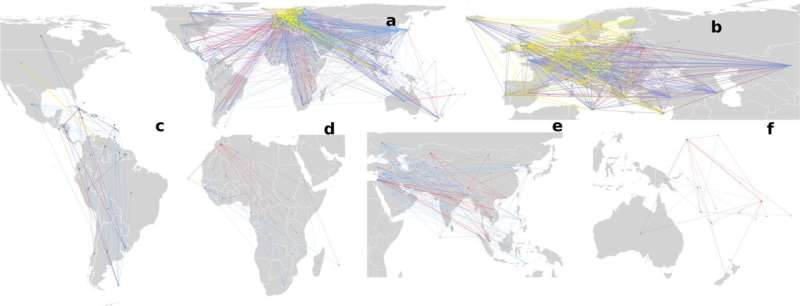The world-wide waste web. Superposition of the W4 networks of types I (red edges), type II (blue edges), and type III (yellow edges) of waste, where the nodes represent the countries which traded the corresponding waste in the years 2001–2019. The direction of the edges indicates the flow from exporter to importer as reported in the BaC database. A view of the global network in (a), with zooms for the local networks of Europe in (b), the Americas (c), Africa (d), Asia (e), and Oceania (f). Map tiles by Bjorn Sandvik, under CC BY-SA 3.0 available at http://thematicmapping.org/downloads/world_borders.php. Credit: Nature Communications (2022). DOI: 10.1038/s41467-022-28810-x
A small team of researchers at the Institute of Interdisciplinary Physics and Complex Systems in Spain has created what they describe as a "worldwide waste web" and have used it to track the movement of hazardous waste around the globe. In their paper published in the journal Nature Communications, the group outlines the factors that went into creating their waste web and what it showed about the movement of hazardous materials around the world.
As the researchers note, approximately 7 to 10 billion metric tons of waste are produced every year. Of that, approximately 300 to 500 metric tons is hazardous waste. As part of efforts to handle such vast amounts of material, a waste trade has evolved. Some countries ship some of their waste to other countries. Those countries are paid to accept it and often use it as a resource. Processing waste can yield a wide variety of valuable materials, such as gold in electronics. In this new effort, the researchers studied the waste trade and as part of that effort, named it the "worldwide waste web" because it is so interconnected.
To gain a better perspective on the waste web, and more specifically the hazardous waste trade, they created a mathematical model to describe its characteristics using data collected from countries around the world over the years 2001 to 2019 (minus data from 2010 that was not available). They found that more than 1.4 million metric tons of hazardous waste was reported by countries adhering to the Basel Convention agreements over the period they studied. They note that an unknown amount of such waste was also dumped illegally.
The researchers also found that they could use their model to identify those countries that were importing and exporting hazardous waste and also those that were at or near a saturation point. They found 28 countries that they deemed to be at high risk of oversaturation, which, they note, could lead to poor handling of such materials. Such situations are likely to lead to environmental and health problems for those near dumping sites. The researchers conclude that their model can be used by others to assess global waste issues, now and in the coming years.
More information: Johann H. Martínez et al, The world-wide waste web, Nature Communications (2022). DOI: 10.1038/s41467-022-28810-x
© 2022 Science X Network
























